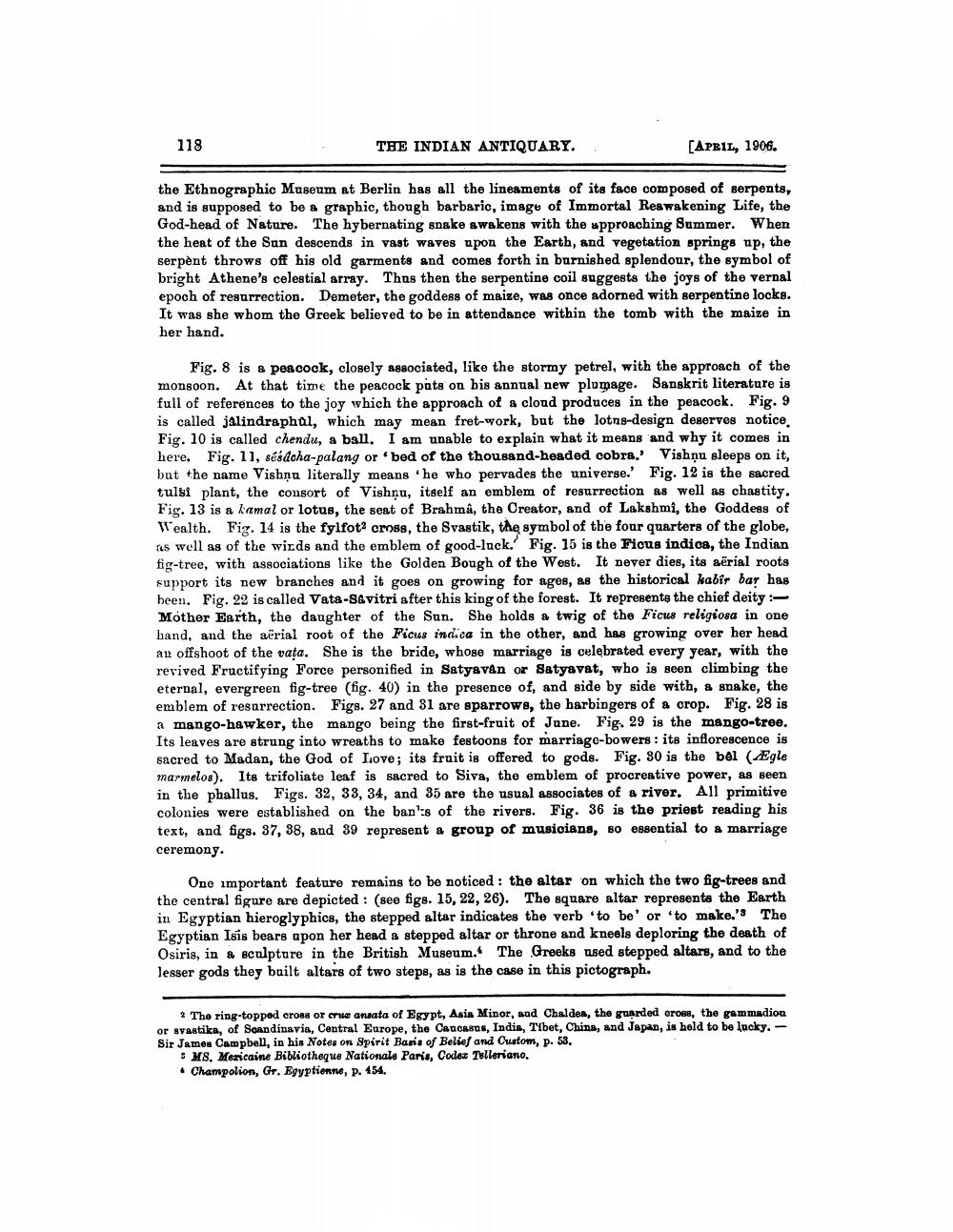________________
118
THE INDIAN ANTIQUARY.
[APRIL, 1906.
the Ethnographic Museum at Berlin has all the lineaments of its face composed of serpents, and is supposed to be a graphic, though barbaric, image of Immortal Reawakening Life, the God-head of Nature. The hybernating snake awakens with the approaching Summer. When the heat of the Sun descends in vast waves upon the Earth, and vegetation springs up, the serpent throws off his old garments and comes forth in burnished splendour, the symbol of bright Athene's celestial array. Thus then the serpentine coil suggests the joys of the vernal epoch of resurrection. Demeter, the goddess of maize, was once adorned with serpentine locks. It was she whom the Greek believed to be in attendance within the tomb with the maize in her hand.
Fig. 8 is a peacock, closely associated, like the stormy petrel, with the approach of the monsoon. At that time the peacock pats on his annual new plumage. Sanskrit literature is full of references to the joy which the approach of a cloud produces in the peacock. Fig. 9 is called jalindraphal, which may mean fret-work, but the lotns-design deserves notice Fig. 10 is called chendu, a ball. I am unable to explain what it means and why it comes in here. Fig. 11, séódcha-palang or 'bed of the thousand-headed cobra. Vishņu sleeps on it, but the name Vishņu literally means he who pervades the universe.' Fig. 12 is the sacred tulsi plant, the consort of Vishņu, itself an emblem of resurrection as well as chastity. Fig. 13 is a kamal or lotus, the seat of Brahma, the Creator, and of Lakshmi, the Goddess of Wealth. Fig. 14 is the fylfot cross, the Svastik, the symbol of the four quarters of the globe, 15 well as of the wirds and the emblem of good-luck.' Fig. 15 is the Fous indioa, the Indian fig-tree, with associations like the Golden Bough of the West. It never dies, its aërial roots support its new branches and it goes on growing for ages, as the historical kabir bar has been. Fig. 22 is called Vata-savitri after this king of the forest. It represents the chief deity :Mother Earth, the daughter of the Sun. She holds a twig of the Ficus religiosa in one hand, and the aërial root of the Ficus indica in the other, and has growing over her head an offshoot of the vata. She is the bride, whose marriage is celebrated every year, with the revived Fructifying Force personified in Satyavan or Satyavat, who is seen climbing the eternal, evergreen fig-tree (fig. 40) in the presence of, and side by side with, & snake, the emblem of resurrection. Figs. 27 and 31 are sparrows, the harbingers of a crop. Fig. 28 is a mango-hawker, the mango being the first-fruit of June. Fig. 29 is the mango-tree. Its leaves are strung into wreaths to make festoons for marriago-bowers : its inflorescence is sacred to Madan, the God of Love; its fruit is offered to gods. Fig. 30 is the bel (Ægle marmelos). Its trifoliate leaf is sacred to Siva, the emblem of procreative power, as seen in the phallus. Figs. 32, 33, 34, and 35 are the usual associates of a river. All primitive colonies were established on the ban's of the rivers. Fig. 36 is the priest reading his text, and figs. 37, 38, and 39 represent a group of musicians, Bo essential to a marriage ceremony.
One important feature remains to be noticed: the altar on which the two fig-trees and the central figure are depicted : (see figs. 15, 22, 26). The square altar represents the Earth in Egyptian hieroglyphics, the stepped altar indicates the verb 'to be' or 'to make.'s The Egyptian Isis bears apon her head a stepped altar or throne and kneels deploring the death of Osiris, in a sculpture in the British Museum. The Greeks used stepped altars, and to the lesser gods they built altars of two steps, as is the case in this pictograph.
? The ring-topped cross or crua anaata of Egypt, Asia Minor, and Chalden, the guarded orose, the gammadion or avastika, of Sonndinavia, Central Europe, the Caucasus, India, Tibet, China, and Japan, is hold to be lucky. - Sir James Campbell, in his Notes on Spirit Basis of Belief and Chatom, p. 53.
SMS. Mericaine Bibliotheque Nationale Paris, Codex Telleriano. • Champolion, Gr. Egyptienne, p. 454.




